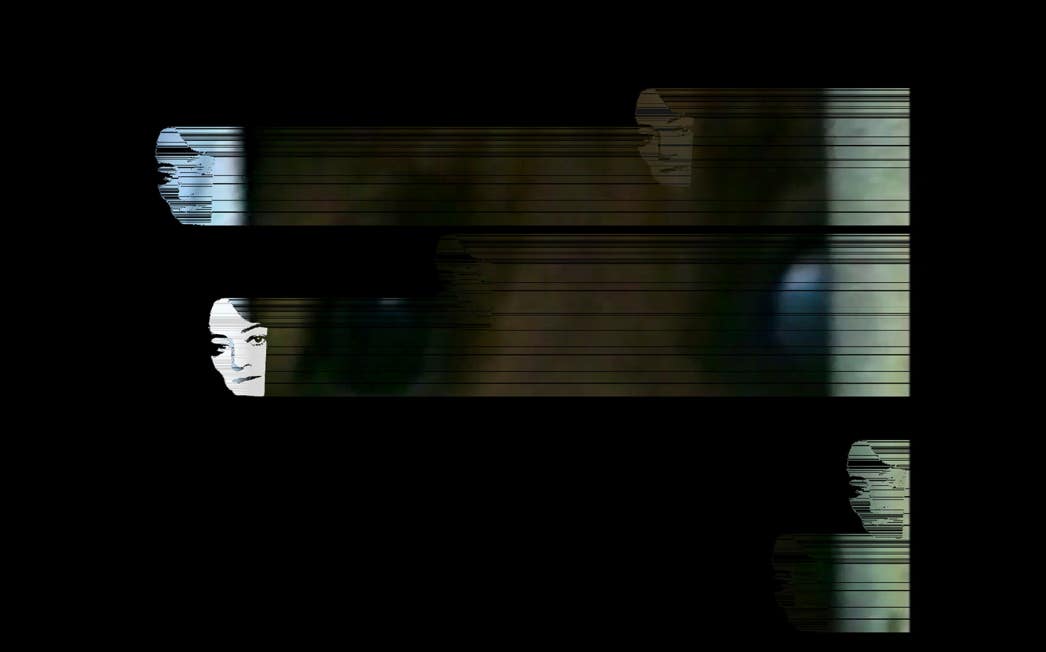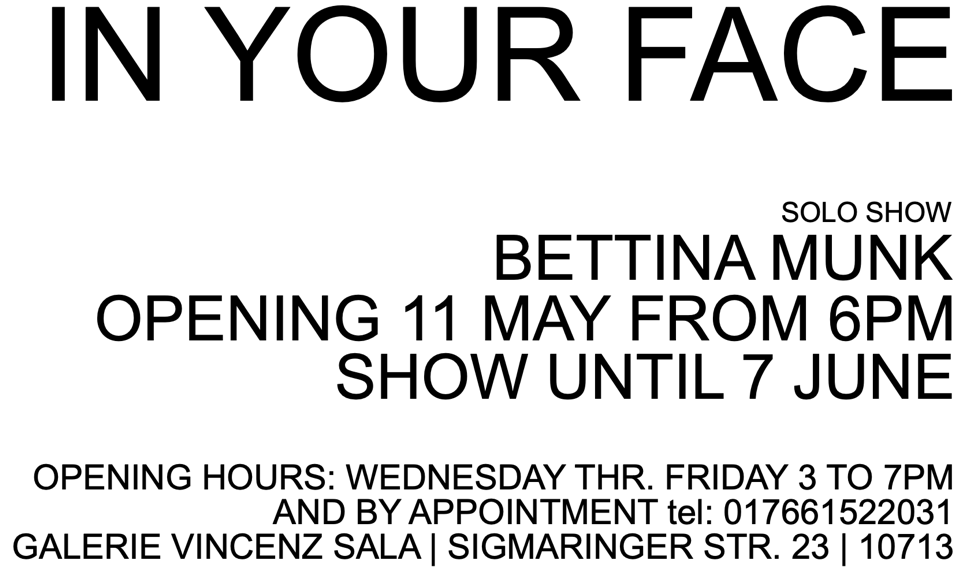


zur Ausstellung
... not just your face. Eine einmal zeichnerische Arbeit. Nun umschweben im Dunkel der Doppelprojektion auf Schablonen zurückgeschnittene Gesichter die vorüberziehenden Liniengespinste - und hinter übergroß flimmerndem Strichcode lautlos bellende Hunde.
Prousts Laterna Magica, der Nachttischlampe aufgesetzt, drehte durchs traurige Warten auf die Abendbrotzeit. Eine Projektion, die, so Proust, nach dem Vorbild gotischer Kathedralenarchitektur und ihrer Glasmalerei die Undurchdringlichkeit der Wände brach. Nicht nur ein sanftes Spektakel. Die Vertrautheit des Zimmers war aufgestört: “… ich kann gar nicht sagen, welchen Kummer mir dieser Einbruch in das Geheimnis und die Schönheit einer Kammer bereitete, die ich schließlich doch so sehr mit meinem eigenen Ich ausgestattet hatte, dass ich ihr keine größere Aufmerksamkeit mehr schenkte als diesem selbst.” Ein schließlich unheimliches Lichtspiel, das Golos Leib und Rüstung durch den Raum schweben ließ, von übernatürlicher Substanz, die jedes Hindernis und noch den Türknauf wie ein Knochengerüst ergriff und in sich aufnahm.
Die Techniken haben sich gewandelt. Nicht mehr gotische Architektur, nicht mehr die Meister der Glasmalerei, nicht mehr das Licht der Nachttischlampe, das die Laterna Magica antreibt. An die Stelle animierter Narration tritt in Munks Projektion die aleatorische Architektur des von ihr geschriebenen Programms, das Gesichter, Liniengespinste, die hinterm Flimmern bellenden Hunden in immer neu variierter Abfolge durch den Raum ziehen lässt. Ein kathedraler Blick ins Sternenlose eines kaum noch kenntlichen und allemal unbekannten Raums, der nur durch den dunkel vernebelten soundtrack von Nicholas Bussmann ungefähr vermessen wird.
„Die Töne zu sich selbst kommen lassen“ heißt es bei Cage. Auch ein Ausschluss. Munks aleatorisches Spiel rückt dem Betrachter mit dem in der Projektion beständig variierten Raum zu Leibe. Raum, in dem sich das eigene Selbst nie hat einrichten können, der nicht einmal zur kreisend animierten Narration der Laterna Magica findet. Die zeichnerischen Versatzstücke treten zurück, werden zum Material. So auch die im New York der 90er Jahre von ihr selbst aufgenommene Sequenz anschlagender Hunde. Auch diese auf “mute” gesetzte Aggression wird zum Material für ein code-schreibendes Handwerk, das mit der Hand der Zeichnerin fast nichts mehr zu tun hat.
Munks Doppelprojektion ist Installation, die den Raum, auch den Raum des Selbst, deinstalliert. Er teilt das Schicksal des zu sich selbst gekommenen Türknaufs, der in Prousts Projektion Golo als Astralleib dient und sich doch zuvor „… von allen Türknäufen der Welt darin unterschied, dass er sich von ganz allein zu öffnen schien, ohne dass ich ihn hätte drehen müssen, derart unbewusst war mir seine Handhabung geworden …“.
‚in your face‘ (and not just the face) handelt von der durchbrochenen Gewohnheit, vom Aufprall, der nicht nur den Türknauf auf eine aleatorisch unabschließbare Durchdringlichkeit überführt. Ein Zusichkommen, dem das Selbst abhanden kommt.
Helmut Bauer
on the show:
... not just your face. A once graphic work. Now, in the darkness of the double projection, faces cut back to stencils hover around passing webs of lines - and behind oversized flickering barcodes, silently barking dogs.
Proust's Laterna Magica, placed on the bedside lamp, rotated through the sad wait for dinner time. A projection that, according to Proust, modelled on Gothic cathedral architecture and its stained glass, broke the impenetrability of the walls. Not just a gentle spectacle. The familiarity of the room was disrupted: ‘... I can't tell you what sorrow this intrusion into the mystery and beauty of a chamber caused me, which I had after all endowed with my own self to such an extent that I no longer paid any more attention to it than to myself.’ An ultimately uncanny play of light that made Golo's body and armour float through the room, of supernatural substance that gripped every obstacle and even the doorknob like a skeleton and absorbed it.
The techniques have changed. No longer Gothic architecture, no longer the masters of stained glass, no longer the light of the bedside lamp that drives the magic lantern. In Munk's projection, animated narration is replaced by the aleatoric architecture of the programme she has written, which allows faces, webs of lines and the dogs barking behind the flickering darkness to move through the room in an ever-changing sequence. A cathedral view into the starlessness of a barely recognisable and always unknown space, which is only roughly measured by Nicholas Bussmann's darkly fogged soundtrack.
"Let the sounds come to themselves" says Cage. Also an exclusion. Munk's aleatoric play confronts the viewer with this unstable space constantly changing in the projection. Space in which one's own self has not had the chance to settle in and not even find the gently turning narrative of the Laterna Magica. The graphic elements recede, become material. Same with the sequence of dogs barking that Munk herself recorded in New York in the 1990s. Also this mute aggression becomes material for a code-writing craft that has almost nothing to do with the draughtswoman's craft.
Munk's double projection is an installation that deinstalls space, including the space of the self. It shares the fate of the doorknob that in Prosut's projection has come to itself serving as Golo's astral body and yet previously ‘... differed from all the doorknobs in the world in that it seemed to open all by itself, without me having to turn it, so unconscious had I become of its handling ...’.
‘in your face’ (and not just the face) is about a gently intruding loss of familiarity, eventually a clash, transfering not just the doorknob to an endless aleatory penetrability. A coming to oneself and getting lost.
Galerie Vincenz Sala
Sigmaringer Str. 23
10713 Berlin
Kontakt: Helmut Bauer
Tel.: +49 176 615 2203 31
e-mail: mail@vsala.com




Diese Website verwendet Cookies. Bitte lesen Sie unsere Datenschutzerklärung für Details.
Verweigern
OK